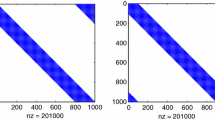Abstract
LetM be a square matrix whose entries are in some field. Our object is to find a permutation matrixP such thatPM P −1 is completely reduced, i.e., is partitioned in block triangular form, so that all submatrices below its diagonal are 0 and all diagonal submatrices are square and irreducible. LetA be the binary (0, 1) matrix obtained fromM by preserving the 0's ofM and replacing the nonzero entries ofM by 1's. ThenA may be regarded as the adjacency matrix of a directed graphD. CallD strongly connected orstrong if any two points ofD are mutually reachable by directed paths. Astrong component ofD is a maximal strong subgraph. Thecondensation D * ofD is that digraph whose points are the strong components ofD and whose lines are induced by those ofD. By known methods, we constructD * from the digraph,D whose adjacency matrixA was obtained from the original matrixM. LetA * be the adjacency matrix ofD *. It is easy to show that there exists a permutation matrixQ such thatQA * Q −1 is an upper triangular matrix. The determination of an appropriate permutation matrixP from this matrixQ is straightforward.
Similar content being viewed by others
References
Harary, F.: A graph theoretic method for the complete reduction of a matrix with a view toward finding its eigenvalues. J. of Mathematics and Physics38, 104–111 (1959).
—, andI. C. Ross: A description of strengthening and weakening group members. Sociometry22, 139–147 (1959)
—: On the consistency of precedence matrices. J. of the Association of Computing Machinery7, 255–259 (1960)
Forsythe, G. E.: Solving linear algebraic equations can be interesting. Bulletin of the Americal Mathematical Society59, 299–329 (1953)
Householder, A. S. A survey of some closed methods for inverting matrices. SIAM J.5, 155–169 (1957)
Parter, S.: On the eigenvalues and eigenvectors of a class of matrices. SIAM J.8, 376–388 (1961)
Swift, G.: A comment on matrix inversion by partition. SIAM Review2, 132–133 (1960)
Author information
Authors and Affiliations
Additional information
This was an informal talk at the International Symposium on Matrix Computation sponsored by SIAM and held in Gatlinburg, Tennessee, April 24–28, 1961 and was an invited address at the SIAM meeting in Stillwater, Oklahoma on August 31, 1961
Rights and permissions
About this article
Cite this article
Harary, F. A graph theoretic approach to matrix inversion by partitioning. Numer. Math. 4, 128–135 (1962). https://doi.org/10.1007/BF01386304
Received:
Issue Date:
DOI: https://doi.org/10.1007/BF01386304




